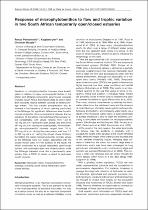 ResearchSpace
ResearchSpace
Response of microphytobenthos to flow and trophic variation in two South African temporarily open/closed estuaries
JavaScript is disabled for your browser. Some features of this site may not work without it.
- ResearchSpace
- →
- Research Publications/Outputs
- →
- Journal Articles
- →
- View Item
| dc.contributor.author |
Perissinotto, R

|
|
| dc.contributor.author |
Iyer, K

|
|
| dc.contributor.author |
Nozais, C

|
|
| dc.date.accessioned | 2007-06-29T08:47:57Z | |
| dc.date.available | 2007-06-29T08:47:57Z | |
| dc.date.issued | 2006 | |
| dc.identifier.citation | Perissinotto, R, Iyer, K and Nozais, C. 2006. Response of microphytobenthos to flow and trophic variation in two South African temporarily open/closed estuaries. Botanica Marina, Vol. 49, pp 10-22 | en |
| dc.identifier.issn | 0006-8055 | |
| dc.identifier.uri | http://hdl.handle.net/10204/779 | |
| dc.description | http://www.atypon-link.com/WDG/doi/pdf/10.1515/BOT.2006.002?cookieSet=1 | en |
| dc.description.abstract | Variations in microphytobenthic biomass were investigated in relation to major environmental factors in the Mdloti and Mhlanga temporarily open/closed estuaries (TOCEs), South Africa, from March 2002 to March 2003. Both estuaries receive different volumes of treated sewage waters. This has caused eutrophication and an increase in the frequency of mouth opening, particularly at the Mhlanga. No significant differences were found in microphytobenthic chl a concentrations between the two estuaries. At the Mdloti, microphytobenthic biomass varied considerably, with values ranging from 1.33 to 131 mg chl a m-2 during the open phase, and from 18 to 391 mg chl a m-2 during the closed phase. At the Mhlanga, microphytobenthic biomass ranged from 7.0 to 313 mg chl a m-2 during the open phase, and from 1.7 to 267 mg chl a m-2 during the closed phase. Unlike in the Mdloti, the higher microphytobenthic biomass values at the Mhlanga were not always associated with the closed mouth state. For the duration of the study, the Mdloti functioned as a typical temporarily open/closed system, with prolonged open and closed phases, while the Mhlanga behaved more like a permanently open estuary than a TOCE (it lacked a period of prolonged mouth closure). | en |
| dc.language.iso | en | en |
| dc.publisher | Walter de Gruyter & Co | en |
| dc.subject | Estuaries | en |
| dc.subject | Freshwater ecosystems | en |
| dc.subject | Mdloti | en |
| dc.subject | Mhlanga | en |
| dc.subject | Eutrophication | en |
| dc.subject | Flow | en |
| dc.title | Response of microphytobenthos to flow and trophic variation in two South African temporarily open/closed estuaries | en |
| dc.type | Article | en |
| dc.identifier.apacitation | Perissinotto, R., Iyer, K., & Nozais, C. (2006). Response of microphytobenthos to flow and trophic variation in two South African temporarily open/closed estuaries. http://hdl.handle.net/10204/779 | en_ZA |
| dc.identifier.chicagocitation | Perissinotto, R, K Iyer, and C Nozais "Response of microphytobenthos to flow and trophic variation in two South African temporarily open/closed estuaries." (2006) http://hdl.handle.net/10204/779 | en_ZA |
| dc.identifier.vancouvercitation | Perissinotto R, Iyer K, Nozais C. Response of microphytobenthos to flow and trophic variation in two South African temporarily open/closed estuaries. 2006; http://hdl.handle.net/10204/779. | en_ZA |
| dc.identifier.ris | TY - Article AU - Perissinotto, R AU - Iyer, K AU - Nozais, C AB - Variations in microphytobenthic biomass were investigated in relation to major environmental factors in the Mdloti and Mhlanga temporarily open/closed estuaries (TOCEs), South Africa, from March 2002 to March 2003. Both estuaries receive different volumes of treated sewage waters. This has caused eutrophication and an increase in the frequency of mouth opening, particularly at the Mhlanga. No significant differences were found in microphytobenthic chl a concentrations between the two estuaries. At the Mdloti, microphytobenthic biomass varied considerably, with values ranging from 1.33 to 131 mg chl a m-2 during the open phase, and from 18 to 391 mg chl a m-2 during the closed phase. At the Mhlanga, microphytobenthic biomass ranged from 7.0 to 313 mg chl a m-2 during the open phase, and from 1.7 to 267 mg chl a m-2 during the closed phase. Unlike in the Mdloti, the higher microphytobenthic biomass values at the Mhlanga were not always associated with the closed mouth state. For the duration of the study, the Mdloti functioned as a typical temporarily open/closed system, with prolonged open and closed phases, while the Mhlanga behaved more like a permanently open estuary than a TOCE (it lacked a period of prolonged mouth closure). DA - 2006 DB - ResearchSpace DP - CSIR KW - Estuaries KW - Freshwater ecosystems KW - Mdloti KW - Mhlanga KW - Eutrophication KW - Flow LK - https://researchspace.csir.co.za PY - 2006 SM - 0006-8055 T1 - Response of microphytobenthos to flow and trophic variation in two South African temporarily open/closed estuaries TI - Response of microphytobenthos to flow and trophic variation in two South African temporarily open/closed estuaries UR - http://hdl.handle.net/10204/779 ER - | en_ZA |





